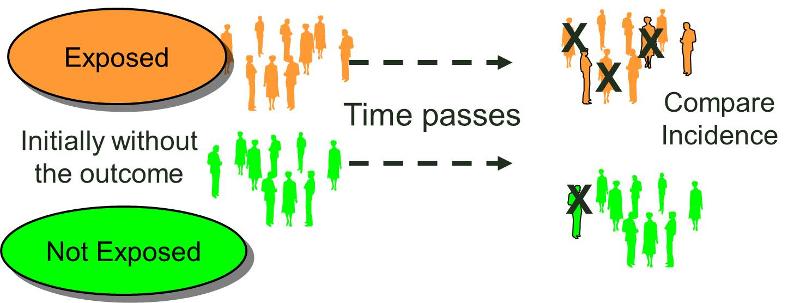
Introduction
The characteristic feature of a cohort study is that the investigator identifies subjects at a point in time when they do not have the outcome of interest and compares the incidence of the outcome of interest among groups of exposed and unexposed (or less exposed) subjects. (We can refer to the groups being compared as exposure cohorts.) Cohorts may be identified retrospectively or prospectively, but in either case the outcome status needs to be established at least twice. It must be established that a cohort did not have the outcome of interest at the beginning of the observation period, and the cohort needs to be examined again to determine whether or not the outcome subsequently developed, i.e., the incidence in each of the exposure groups.
study is that the investigator identifies subjects at a point in time when they do not have the outcome of interest and compares the incidence of the outcome of interest among groups of exposed and unexposed (or less exposed) subjects. (We can refer to the groups being compared as exposure cohorts.) Cohorts may be identified retrospectively or prospectively, but in either case the outcome status needs to be established at least twice. It must be established that a cohort did not have the outcome of interest at the beginning of the observation period, and the cohort needs to be examined again to determine whether or not the outcome subsequently developed, i.e., the incidence in each of the exposure groups.
Learning Objectives
Upon successful completion of this section of the course, the student will be able to:
- Define what a cohort study is and explain its key features.
- Distinguish between "closed" and "open" cohorts.
- Define and distinguish among:
- Prospective cohort study
- Retrospective cohort study
- Ambidirectional study
- Explain the advantages and disadvantages of the cohort design in general and the strengths and weaknesses of retrospective and prospective cohort studies.
- Explain the factors that should be considered in selecting subjects for a cohort study.
- Differentiate between a specific/special exposure cohort and a general cohort.
- Explain what is meant by the term "comparison group".
- Explain the differences among the following types of comparison groups:
- An internal comparison group
- An external comparison group
- A general population comparison group
- Explain what the "healthy worker effect" is.
- Define "loss to follow-up" and explain what effects it may have on a study.



